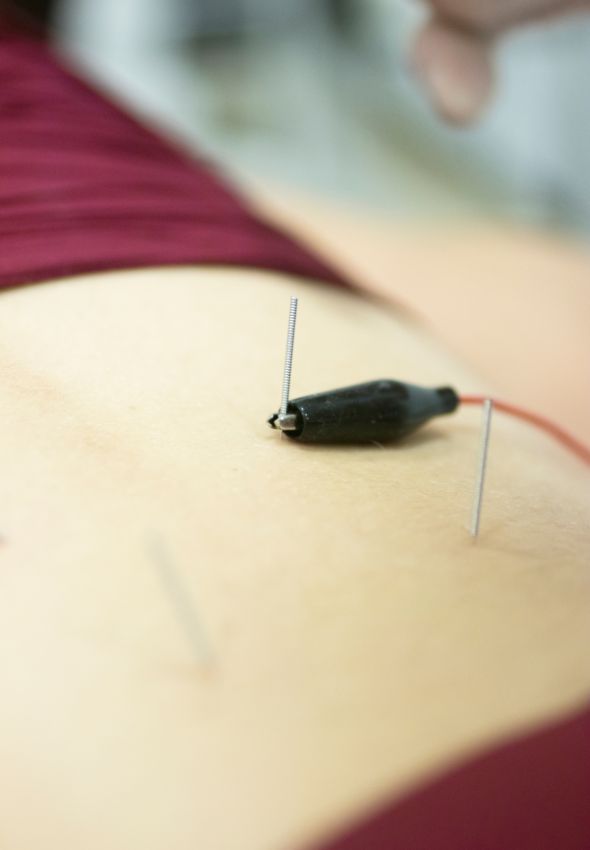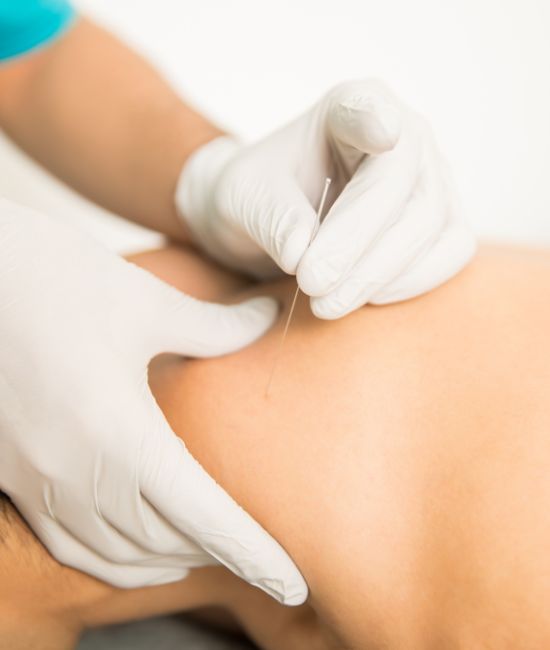Functional Dry Needling /Intramuscular Stimulation
Dry needling physiotherapy is also known as intramuscular stimulation (IMS). Physiotherapists and other healthcare professionals use a technique to treat myofascial pain. This method involves inserting thin, solid needles into specific trigger points or tight bands of muscle tissue without injecting any substance (hence the term “dry” needling).
How Dry Needling Physiotherapy Works
- Identification of Trigger Points: The practitioner identifies areas of muscle tightness or trigger points, which are hyperirritable spots in the muscle associated with palpable nodules in taut bands of muscle fibers.
- Insertion of Needles: Thin, sterile needles are inserted through the skin directly into these trigger points or muscle knots. The depth and angle of insertion can vary depending on the location and size of the muscle being treated.
- Stimulation: The needles may be manipulated manually or with electrical stimulation (e-stim) to provoke a local twitch response (LTR), an involuntary muscle contraction. This twitch response can help release the tension in the muscle.
- Pain Relief and Healing: Needling’s mechanical and biochemical effects can increase blood flow, reduce inflammation, and trigger a healing response in the tissue, resulting in decreased pain and improved function.
Benefits Of IMS Treatments And Uses
- Pain Relief: Dry needling physiotherapy is often used to relieve pain associated with myofascial pain syndrome, which can cause chronic pain and dysfunction in various parts of the body.
- Improved Range of Motion: Dry needling physiotherapy can help improve flexibility and range of motion by releasing tight muscles and fascia.
- Enhanced Muscle Function: It can improve muscle activation patterns and overall muscle function, making it useful in sports rehabilitation and performance enhancement.
- Reduction of Chronic Pain: Chronic back pain, neck pain, and headaches can benefit from dry needling physiotherapy.

What Can Intramuscular Stimulation/Trigger Point Needling Help With?
Intramuscular Stimulation (IMS)/Trigger Point Needling is a form of therapy that can help with various conditions. Some common issues that it may be beneficial for include musculoskeletal pain and dysfunction, chronic tension headaches, sports injuries, and post-surgical rehabilitation.
Conditions Treated With IMS Dry Needling Physiotherapy
- Myofascial pain syndrome
- Chronic pain conditions (e.g., fibromyalgia)
- Sports injuries (e.g., tennis elbow, runner’s knee)
- Musculoskeletal pain (e.g., back pain, neck pain)
- Headaches and migraines
IMS Assessment and Functional Dry Needling Treatment Sessions
IMS Assessment Session
Patient History:
- Medical History Review: The physiotherapist reviews the patient’s medical history, including past injuries, surgeries, and current medications.
- Pain Description: The patient describes the nature, location, intensity, and duration of their pain.
- Functional Impact: Discussion on how pain affects daily activities and overall function.
Physical Examination:
- Posture Analysis: Our physiotherapist in Surrey observes the patient’s posture and alignment to identify imbalances or asymmetries.
- Movement Assessment: The patient performs specific movements to assess range of motion, muscle strength, and functional limitations.
- Palpation: Our physio team palpates (feels) the muscles and tissues to identify tight bands, trigger points, and areas of tenderness.
- Neurological Examination: A neurological exam is performed to assess nerve function and identify any related issues.
Diagnosis:
- Identification of Trigger Points: Our physiotherapist identifies specific muscles and trigger points contributing to the pain based on the assessment.
- Pain Mapping: A map of the affected areas is created to guide the dry needling physiotherapy treatment.
IMS Treatment Session
Preparation:
- Explanation: The practitioner explains the dry needling physiotherapy treatment process, including what the patient can expect during and after the session.
- Positioning: The patient is positioned comfortably to allow access to the treatment areas.
Dry Needling Procedure:
- Sterilization: The treatment area is cleaned with an antiseptic.
- Needle Insertion: Thin, sterile needles are inserted into the identified trigger points. The depth and angle of insertion depend on the muscle and its location.
- Needle Manipulation: The needles may elicit a local twitch response (LTR). The practitioner may also use pistoning (moving the needle up and down) or twisting.
- E-stim (Optional): In some cases, electrical stimulation may be applied to the needles to enhance the dry needling physiotherapy treatment effect.
Post-Treatment:
- Needle Removal: The needles are carefully removed, and the treated area is cleaned again.
- Immediate Response: The practitioner assesses the immediate response to dry needling physiotherapy treatment, such as changes in pain levels or range of motion.
- Aftercare Instructions: The patient receives instructions on what to expect post-treatment, including potential soreness, avoiding activities, and recommended exercises or stretches.

Follow-up And Progress Monitoring For Dry Needling Physiotherapy Treatments
- Subsequent Sessions: Follow-up sessions are scheduled based on the patient’s response to treatment. These sessions involve reassessment and additional dry needling as needed.
- Progress Tracking: The patient’s progress is tracked over time, with adjustments made to the dry needling physiotherapy treatment plan as necessary. This might include incorporating other therapeutic modalities such as manual therapy, exercise, or education on posture and ergonomics.
Overall, IMS assessments and treatment sessions are designed to be thorough and patient-centered. They aim to relieve pain and improve function through targeted needling of myofascial trigger points.
Safety And Considerations For Functional Dry Needling Therapy Service
- Qualified Practitioners: It is crucial to have dry needling performed by a trained and certified practitioner to ensure safety and effectiveness.
- Potential Side Effects: While generally safe, some patients might experience temporary soreness, bruising, or bleeding at the needle insertion sites.
- Contraindications: Not suitable for individuals with needle phobia, certain blood disorders, or infections at the treatment site.
Revive Rehab is one of the best physiotherapy clinics in Abbotsford and Surrey. Book your appointment today.
